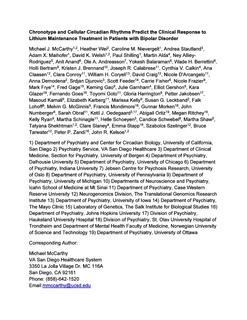Chronotype and cellular circadian rhythms predict the clinical response to lithium maintenance treatment in patients with bipolar disorder
| dc.contributor.author | McCarthy, Michael J. | |
| dc.contributor.author | Stautland, Andrea | |
| dc.contributor.author | Jakobsen, Petter | |
| dc.contributor.author | Ødegaard, Ketil Joachim | |
| dc.contributor.author | Andreassen, Ole Andreas | |
| dc.contributor.author | Djurovic, Srdjan | |
| dc.contributor.author | Morken, Gunnar | |
| dc.contributor.author | Schøyen, Helle Kristine | |
| dc.contributor.author | McInnis, Melvin G. | |
| dc.contributor.author | Alda, Martin | |
| dc.contributor.author | Gage, Fred H. | |
| dc.contributor.author | Calabrese, Joseph R. | |
| dc.contributor.author | Zandi, Peter P. | |
| dc.contributor.author | Nievergelt, Caroline M. | |
| dc.contributor.author | Shilling, Paul D. | |
| dc.contributor.author | Kelsoe, John R. | |
| dc.date.accessioned | 2019-04-02T12:05:44Z | |
| dc.date.available | 2019-04-02T12:05:44Z | |
| dc.date.created | 2019-01-24T11:09:40Z | |
| dc.date.issued | 2018 | |
| dc.identifier.issn | 0893-133X | |
| dc.identifier.uri | http://hdl.handle.net/11250/2592937 | |
| dc.description.abstract | Bipolar disorder (BD) is a serious mood disorder associated with circadian rhythm abnormalities. Risk for BD is genetically encoded and overlaps with systems that maintain circadian rhythms. Lithium is an effective mood stabilizer treatment for BD, but only a minority of patients fully respond to monotherapy. Presently, we hypothesized that lithium-responsive BD patients (Li-R) would show characteristic differences in chronotype and cellular circadian rhythms compared to lithium non-responders (Li-NR). Selecting patients from a prospective, multi-center, clinical trial of lithium monotherapy, we examined morning vs. evening preference (chronotype) as a dimension of circadian rhythm function in 193 Li-R and Li-NR BD patients. From a subset of 59 patients, we measured circadian rhythms in fibroblasts longitudinally over 5 days using a bioluminescent reporter (Per2-luc). We then estimated circadian rhythm parameters (amplitude, period, phase) and the pharmacological effects of lithium on rhythms in cells from Li-R and Li-NR donors. Compared to Li-NRs, Li-Rs showed a difference in chronotype, with higher levels of morningness. Evening chronotype was associated with increased mood symptoms at baseline, including depression, mania, and insomnia. Cells from Li-R patients were more likely to exhibit a short circadian period, a linear relationship between period and phase, and period shortening effects of lithium. Common genetic variation in the IP3 signaling pathway may account for some of the individual differences in the effects of lithium on cellular rhythms. We conclude that circadian rhythms may influence response to lithium in maintenance treatment of BD. | nb_NO |
| dc.language.iso | eng | nb_NO |
| dc.publisher | Springer Nature | nb_NO |
| dc.title | Chronotype and cellular circadian rhythms predict the clinical response to lithium maintenance treatment in patients with bipolar disorder | nb_NO |
| dc.type | Journal article | nb_NO |
| dc.type | Peer reviewed | nb_NO |
| dc.description.version | acceptedVersion | nb_NO |
| dc.source.pagenumber | 620–628 | nb_NO |
| dc.source.volume | 44 | nb_NO |
| dc.source.journal | Neuropsychopharmacology | nb_NO |
| dc.identifier.doi | 10.1038/s41386-018-0273-8 | |
| dc.identifier.cristin | 1664274 | |
| dc.description.localcode | © 2018. This is the authors’ accepted and refereed manuscript to the article. Locked until 16.5.2019 due to copyright restrictions. | nb_NO |
| cristin.unitcode | 194,65,1,0 | |
| cristin.unitname | MH fakultetsadministrasjon | |
| cristin.ispublished | true | |
| cristin.fulltext | postprint | |
| cristin.qualitycode | 2 |
Files in this item
This item appears in the following Collection(s)
-
Institutt for psykisk helse [1221]
-
Publikasjoner fra CRIStin - NTNU [37963]
